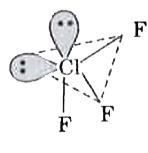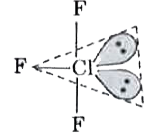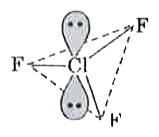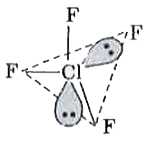In order to explain the characteristic geometrical shapes of polyatomic molecules, Pauling introduced the concept of hybridisation. The orbitals undergoing hybridisation should have nearly same energy. There are various types of hybridisations involving s, p and d - type of orbitals. The type of hybridisation gives the characteristic shape of the molecular or ion.
Which of the following molecule/ion does not have same number of lone pairs?
SF4
PH3
ClO−3
XeF2
The correct Answer is:D
To determine which molecule or ion does not have the same number of lone pairs on the central atom, we will analyze the hybridization and lone pairs of each given molecule/ion.
1. Identify the Molecules/Ions: We need to analyze the following molecules/ions: SF4, PH3, ClO3^-, and XeF2.
2. Determine Valence Electrons:
- SF4 (Sulfur Tetrafluoride):
- Sulfur has 6 valence electrons.
- 4 fluorine atoms contribute 4 electrons.
- Total = 6 + 4 = 10 electrons.
- PH3 (Phosphine):
- Phosphorus has 5 valence electrons.
- 3 hydrogen atoms contribute 3 electrons.
- Total = 5 + 3 = 8 electrons.
- ClO3^- (Chlorate Ion):
- Chlorine has 7 valence electrons.
- 3 oxygen atoms contribute 3 electrons.
- The negative charge adds 1 electron.
- Total = 7 + 3 + 1 = 11 electrons.
- XeF2 (Xenon Difluoride):
- Xenon has 8 valence electrons.
- 2 fluorine atoms contribute 2 electrons.
- Total = 8 + 2 = 10 electrons.
3. Calculate Hybridization:
- SF4:
- Hybridization = 1/2 * (10) = 5 (sp3d).
- Lone pairs = 1 (4 bond pairs + 1 lone pair).
- PH3:
- Hybridization = 1/2 * (8) = 4 (sp3).
- Lone pairs = 1 (3 bond pairs + 1 lone pair).
- ClO3^-:
- Hybridization = 1/2 * (11) = 4 (sp3).
- Lone pairs = 1 (3 bond pairs + 1 lone pair).
- XeF2:
- Hybridization = 1/2 * (10) = 5 (sp3d).
- Lone pairs = 3 (2 bond pairs + 3 lone pairs).
4. Compare Lone Pairs:
- SF4: 1 lone pair
- PH3: 1 lone pair
- ClO3^-: 1 lone pair
- XeF2: 3 lone pairs
5. Conclusion: The molecule that does not have the same number of lone pairs as the others is XeF2, which has 3 lone pairs, while the others have only 1 lone pair.
Final Answer:
XeF2 does not have the same number of lone pairs as the other molecules.
- SF4 (Sulfur Tetrafluoride):
- Sulfur has 6 valence electrons.
- 4 fluorine atoms contribute 4 electrons.
- Total = 6 + 4 = 10 electrons.
- PH3 (Phosphine):
- Phosphorus has 5 valence electrons.
- 3 hydrogen atoms contribute 3 electrons.
- Total = 5 + 3 = 8 electrons.
- ClO3^- (Chlorate Ion):
- Chlorine has 7 valence electrons.
- 3 oxygen atoms contribute 3 electrons.
- The negative charge adds 1 electron.
- Total = 7 + 3 + 1 = 11 electrons.
- XeF2 (Xenon Difluoride):
- Xenon has 8 valence electrons.
- 2 fluorine atoms contribute 2 electrons.
- Total = 8 + 2 = 10 electrons.
- SF4:
- Hybridization = 1/2 * (10) = 5 (sp3d).
- Lone pairs = 1 (4 bond pairs + 1 lone pair).
- PH3:
- Hybridization = 1/2 * (8) = 4 (sp3).
- Lone pairs = 1 (3 bond pairs + 1 lone pair).
- ClO3^-:
- Hybridization = 1/2 * (11) = 4 (sp3).
- Lone pairs = 1 (3 bond pairs + 1 lone pair).
- XeF2:
- Hybridization = 1/2 * (10) = 5 (sp3d).
- Lone pairs = 3 (2 bond pairs + 3 lone pairs).
- SF4: 1 lone pair
- PH3: 1 lone pair
- ClO3^-: 1 lone pair
- XeF2: 3 lone pairs
XeF2 does not have the same number of lone pairs as the other molecules.
Topper's Solved these Questions
- CHEMICAL BONDING AND MOLECULAR STRUCTUREBOOK - MODERN PUBLICATIONCHAPTER - CHEMICAL BONDING AND MOLECULAR STRUCTUREEXERCISE - OBJECTIVE TYPE QUESTIONS (D. MULTIPLE CHOICE QUESTIONS)(Matching Type Question)
2 Videos
- CHEMICAL BONDING AND MOLECULAR STRUCTUREBOOK - MODERN PUBLICATIONCHAPTER - CHEMICAL BONDING AND MOLECULAR STRUCTUREEXERCISE - OBJECTIVE TYPE QUESTIONS (D. MULTIPLE CHOICE QUESTIONS)(Matrix Match Type Question)
6 Videos
- CHEMICAL BONDING AND MOLECULAR STRUCTUREBOOK - MODERN PUBLICATIONCHAPTER - CHEMICAL BONDING AND MOLECULAR STRUCTUREEXERCISE - OBJECTIVE TYPE QUESTIONS (C. MULTIPLE CHOICE QUESTIONS)
12 Videos
- CLASSIFICATION OF ELEMENTS AND PERIODICITY IN PROPERTIES BOOK - MODERN PUBLICATIONCHAPTER - CLASSIFICATION OF ELEMENTS AND PERIODICITY IN PROPERTIES EXERCISE - UNIT PRACTICE TEST
13 Videos
Similar Questions
Knowledge Check
In order to explain the characteristic geometrical shapes of polyatomic molecules, Pauling introduced the concept of hybridisation. The orbitals undergoing hybridisation should have nearly same energy. There are various types of hybridisations involving s, p and d - type of orbitals. The type of hybridisation gives the characteristic shape of the molecular or ion.
Which molecule does not have the same type of hybridisation as P has in PF5?AClF3BSF4CXeF4DXeF2In order to explain the characteristic geometrical shapes of polyatomic molecules, Pauling introduced the concept of hybridisation. The orbitals undergoing hybridisation should have nearly same energy. There are various types of hybridisations involving s, p and d - type of orbitals. The type of hybridisation gives the characteristic shape of the molecular or ion.
Which of the following has correct placement of lone pairs and bond pairs?A B
B C
C D
D
In which of the following pairs both molecules do not possess same type of hybridisation?
ACH4 and H2OBPCl5 and SF4CSF4 and XeF4DBCl3 and NCL3
In which of the following pairs of molecules/ions, the central atoms have sp2 hybridisation?
View SolutionWhich of the following is/are not essential condition(s) for hybridisation?
(i) The orbitals present in the valence shell of the atom are hybridisation.
(ii) The orbital undergoing hybridisation should have almost equal energy.
(iii) Promotion of electron is essential prior to hybridasation
(iv) Only half filled orbital participal in hybridisation
View SolutionAssertion : Molecular having different hybridisation can have same shape.
Reason :The shape of a molecule does not depend on the hybridisation but it depends on the energy factor.
View SolutionWhich of following pair of species is having different hybridisation but same shape.
View SolutionHybridisation is a theoretical concept, as state of hybridisation can not be detected ever the spectroscopically: unlike intermediates or transition state in various reactions but it corrects the predictions which are based on overlapping of pure atomic orbitals. VSEPR theory predicts precisely shape and bond angle in a given molecule.
Which of the following molecule /ions which are not planr?
View Solution
